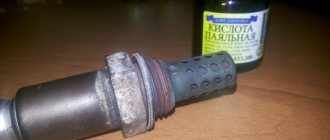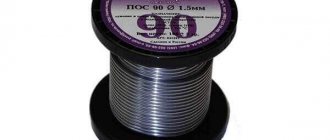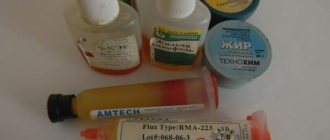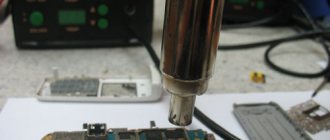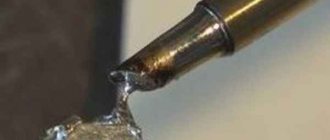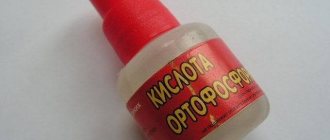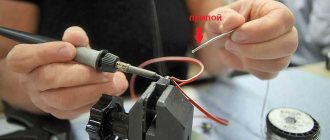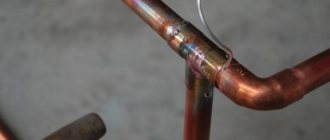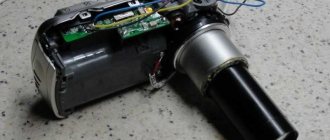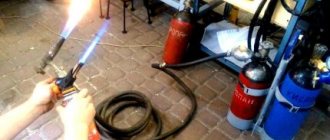DIY liquid rosin
During the soldering process, a liquid variety of rosin is often used.
This is a neutral medium that can be used to work with almost any metals, as it will not harm them. You can make liquid rosin yourself without any problems, but there are also options for finished products from suppliers. This substance is often used in cases where it is necessary to cover a large surface with flux. Due to the liquid structure, there are practically no problems with removing material residues from the surface, as is the case with solid fluxes. When considering options for making liquid rosin, there are always several varieties. Almost all organic liquids can dissolve solid rosin, especially if they are heated. The main thing is that the dissolved medium retains its properties, albeit not in such a high concentration as before.
In addition, the material acquires its main advantage - a high level of spreadability. After receiving the solution, no additional preparations are required and everything can be used almost immediately after receiving the solution. It is worth noting that homemade fluxes can then be changed, supplementing them with new particles of rosin, or diluted with a solvent. But here you cannot use a different liquid for dissolution than the one that was used in the original composition.
Benefits of using rosin
The obvious advantages of using this substance for soldering include the following.
- Rosin is a dielectric and has excellent insulating properties.
- It can be easily purchased. Rosin is an affordable material sold in any store that has a hardware department.
- Budget price compared to other materials used as a flux for soldering.
- The ability to carry out soldering with its help even at low air temperatures.
- It can be used both when working in a home workshop and on an industrial scale.
- Rosin is not exposed to moisture since it does not dissolve in water.
- Has a relatively long shelf life.
- Degreases parts and removes oxide films from them.
- Rosin can be used without additional protection.
- This material is non-toxic and can be used without the use of additional protective equipment.
Physico-chemical properties and composition
Before looking at how to melt rosin, it's worth considering what goes into it. The composition of the material is quite simple, since a person will need only two main components for preparation. most often this is rosin itself and alcohol, which is used as an organic solvent. With proper preparation and adherence to the technological regime, the final product looks like a homogeneous substance.
Using alcohol for liquid rosin
Water can be used together with alcohol, but it is used as an additional material, since it cannot dissolve the flux on its own. Factory brands also use additional corrosion inhibitors, additives, propanol and other elements.
The density of the liquid depends on the amount of rosin itself in the composition. The properties affecting soldering almost completely replicate those possessed by solid tallow rosin. But in the dissolved version they do not appear so strongly. Due to increased spreadability, the liquid gets into all the small irregularities that exist in the metal and this gives a much higher level of bonding than in initially solid flux brands. The main chemical property here is the neutrality of the environment, therefore, the composition is suitable for use with almost any part.
The use of rosin as a soldering flux
The use of rosin as a soldering flux is due to its ability, in the molten state, to dissolve oxide films on the surface of the metals being soldered. Chemically, metal oxides are partially reduced to metal and partially converted into low-melting salts of resin acids - resinates.
It is generally accepted that rosin is a good dielectric. The dielectric characteristics of an ultra-pure dehydrated laboratory sample of rosin insulation are indeed quite high, but the real value of the volumetric resistance of rosin under normal conditions is three orders of magnitude less than the values obtained in the laboratory. In addition, rosin is not very resistant to atmospheric moisture, under the influence of which it is hydrolyzed and saponified, and due to the hygroscopicity of the resulting compounds, their corrosion increases. Therefore, as a durable dielectric, it can only be used in sealed electrical devices, as an insulator in power cables, etc. Also, the introduction of large quantities of rosin into electrical insulating varnishes reduces their moisture and water resistance to varying degrees, and such varnishes soften with increasing temperature. In addition, when such varnishes are heated above the melting point, their dielectric properties deteriorate.
In amateur radio practice, a solution of rosin in ethyl or isopropyl alcohol is popular for soldering. Sometimes, to increase the effectiveness of such a flux, glycerin is added to the solution. When making soldering rosin flux by dissolving rosin in alcohol, the solution should not be made too concentrated: it is enough for it to be only slightly yellowish, since when using a weak solution its effectiveness practically does not decrease, but it makes it much easier to clean soldered products, such as printed circuit boards, from it. residues and the soldering iron tip become noticeably less dirty.
For soldering heavily contaminated or heavily oxidized surfaces, rosin-alcohol-glycerin fluxes are ineffective. In such cases, it is recommended to use inorganic, for example,. In addition, glycerin, due to its hygroscopicity, promotes corrosion of conductors and electrical leaks along the surface of the dielectric of the board, therefore, residues of flux with glycerin should be removed after soldering especially carefully.
Materials and tools for manufacturing
Before melting rosin, you need to prepare by selecting the required number of materials and tools. As consumables, you will need the brand of rosin itself, alcohol, and water if you need to dilute the material.
The tools you will need are:
- A burner or gas stove on which you can heat the liquid for subsequent dissolution;
- Spoon for mixing and dosing the created powder;
- A mortar or other container where you can crush solid rosin into crystalline powder to the finest possible state;
- An object that can be used to crush solid rosin in a mortar;
- Container for storing prepared flux.
Technology and proportions
Considering further points on how to dissolve rosin at home, you should dwell in more detail on the practical part. First of all, you should start by preparing the rosin. It needs to be split into small pieces and then crushed to a powdery state. This is necessary so that the material dissolves better and faster during the process.
Ground solid rosin
The substance itself is very fragile, so there should be no problems with this process. Liquid rosin should not have sediment.
After obtaining the crystalline powder, or during the start of its preparation, you should begin to heat the solvent. The higher its temperature, the faster it will act. The proportions may vary, but most often they take 60% solvent and 40% powder. When the liquid has reached the desired temperature, you can begin to mix the powder. Gradually stirring the substance with a spoon, you need to wait until all the particles turn into a liquid state. At the same time, the mixture should change color to yellowish.
You can add the powder to the solvent until a precipitate begins to form. This means that the ability to dissolve has already come to an end. To increase this parameter, you need to increase the temperature or volume of the liquid. Once you have prepared the required amount of rosin, you can let it cool if everything is very hot, or use it right away. In this state, the material can be stored for quite a long time.
How to properly prepare liquid rosin at home
There are several ways to carry out this procedure, different from the above. For example, you can learn how to melt rosin in a water bath, and so on. But the main thing is to adhere to the basic rules that will help you obtain the correct composition that can be used for soldering, regardless of the method of production.
First of all, you should not use untested supplements. This substance is distinguished by its versatility and simplicity, so foreign substances can give it a more aggressive environment.
Do not use untested solvents. They can not only worsen the properties of the adhesion, but also harm health when in contact with them.”
If all the rules are followed, liquid rosin is produced completely safely and does not take a long time.
How to make liquid rosin
Rosin is a natural material that is obtained from the resin of coniferous trees by evaporating turpentine. After processing, a solid translucent resin is obtained, which is used as a soldering flux. Rosin is used not only in its pure form, but also in combination with various chemical additives. Rosin is mainly used in amateur radio as a cheap and high-quality flux. For soldering radio components and tinning printed circuit boards, it is very convenient to use an alcohol solution of rosin. Liquid rosin easily penetrates into all hard-to-reach places, both when soldering SMD components and conventional radio components, does not leave dirty marks on the board and, if necessary, is easily washed off with acetone or alcohol. Rosin easily dissolves the film of oxides formed on the surface of radio elements during the soldering process, and also reduces the surface tension of the solder melted by the soldering iron tip, allowing it to spread evenly over the entire surface of the soldering area.
In radio stores, the shelves are simply full of various expensive and cheap, chemical, acidic and natural fluxes based on pine rosin. There's a lot of choice, I don't want to take it. But as a real radio amateur, for the sake of experiment, I wanted to prepare an alcohol solution of rosin with my own hands. As my grandfather, an avid radio amateur, did.
Enough words, now I’ll start my experiment, I just can’t wait to see what happens in the end...
As always, I prepared very carefully for the experiment: I took two 20 grams. jars of pine rosin, 100 ml. pure 96° alcohol and an empty plastic bottle for preparing liquid rosin.
What is rosin
Rosin (full name - colophon resin) is the resin of coniferous trees purified in a special way. Rosin is an amorphous, fragile substance consisting of glassy pieces whose appearance resembles the familiar natural amber.
Methods of obtaining
In industrial production, colophon resin is obtained in several ways..
- From resin. Basically, to obtain rosin, the method of heat treatment of the sap of coniferous wood - resin is used. After substances such as water and turpentine are evaporated from it, translucent solid pieces of rosin are formed, which will then be subjected to further chemical purification.
- Extraction method. In this method, colophon resin is extracted from specially crushed wood using solvents.
- Tall oil distillation method. This crude oil is a waste product from the manufacture of pulp and paper products.
You can learn about the method and from what raw materials rosin was obtained from its name: pine (harpius), tallow, extraction, and so on.
Properties
In addition to the fact that colophon resin is an excellent natural dielectric, other features are known:
- It dissolves well with organic solvents such as gasoline and chloroform, ether, alcohol and acetone. But rosin cannot be dissolved with ordinary water.
- The melting point of this solid directly depends on what source and exactly how it was obtained. Basically, it fluctuates between temperatures from 50 to 70 degrees, in some cases the temperature limit can reach 130 degrees Celsius.
- The constituent substance of rosin contains a huge amount of resin acids (up to 90%), the main of which is abietic acid.
- The resin is easily destroyed by mechanical stress.
The color of the resin can vary from light yellow to dark brown. The rich shade of this natural substance indicates that the purification of the resin was not carried out in an entirely correct way and it contains a large number of impurities that worsen its qualities and affect its properties. The darker the color of the substance, the lower the electrical insulating properties of rosin. Properly processed material has a pleasant lemon tint and is an excellent natural insulator.
Where else can resin be used?
This resin is used not only as a flux for soldering . It is also used for many other purposes:
- in the production of various varnishes and paints;
- as one of the materials used in the manufacture of plastics;
- when processing strings and bows for musical instruments;
- for rubbing the soles of ballet shoes;
- to create a smoke screen effect and other effects in the film industry.
Rosin will help with skin and joint problems
Rosin is a light yellow, brittle and hard substance that consists of resinous substances obtained from coniferous trees after distilling off turpentine.
Depending on what type of raw material it is obtained from, it comes in different types. Resin rosin is obtained after distilling turpentine from purified resin. Extraction - after extraction of resinous wood, most often pine, with gasoline. Talwood is prepared by the method of fractional distillation of tall oil.
Varieties of pine rosin
There are several types by which species can be distinguished. First of all, it is worth noting the physical condition. Solid pine rosin is considered the standard option, since it is more concentrated and retains its properties better. It can be simply melted with a soldering iron and moved onto the workpiece, or it can be split into small pieces and laid out on the surface. The second state is liquid, which is obtained in solution from alcohol or another substance. This flux is used for hard-to-reach places and has a neutral medium.
In addition, the material is also distinguished by its production method:
Gum - it is considered the most natural product of all possible in this series. The flux is obtained directly from pine resin, which determines its name. The extraction process is relatively cheap compared to other tree species, but it is more expensive than other options for obtaining rosin, such as chemical methods.
Pine gum rosin
Extraction - here pine rosin is obtained through the method of extracting pine wood with gasoline. Here fatty acids already appear in the composition, and the acid number also increases, which now reaches 155. The flux can be melted at a temperature of 55-58 degrees Celsius. The material can be lightened chemically, since its color is darker than that of resin, which will help bring the properties of these two options closer together.
Pine extraction rosin
Also, pine rosin can be divided into several varieties, as the quality increases:
- Second;
- First;
- Higher.
Coniferous resin in everyday life and in folk medicine
Rosin is used for sizing paper, for making sealing wax, varnishes, soap, ointments, plasters, lubricating oils, plastics and electrical cables. It is also used in everyday life for soldering various metals. Violinists rub rosin on their bows, and dancers rub the soles of their shoes.
How to make rosin at home
- To prepare rosin at home, you will need resin from coniferous trees.
The most commonly used resins are pine and spruce resins. To do this, the resin needs to be scraped off with a spoon and placed in a tin can or pot. - It is best to cook rosin over an open fire, since turpentine vapors during cooking have a very specific smell. You need to put resin in the pot and put it on the fire. Periodically you need to stir it and collect floating debris and foam.
- The resin must be heated until the boiling stops and the turpentine ceases to be released. Do not build a strong fire, as turpentine vapors are highly flammable. If this happens, under no circumstances should you fill it with water, but rather cover the pot with a piece of thick fabric, limiting the access of oxygen to it.
- After the boiling stops, the pot will have a viscous mass of light yellow color. You need to prepare cardboard forms in advance into which rosin is poured. Cardboard for preparing molds is the optimal material, as it is convenient to remove the finished product from it.
- If you need the purest rosin, you can strain it hot using a metal strainer. Since it hardens very quickly, you need to work at maximum speed.
- The rosin must be left in the air for it to harden. It is better not to pour the remains at the bottom of the pot into the mold, as debris usually accumulates there.
In folk medicine, rosin is used mainly externally. It has anti-inflammatory, antiseptic and antiallergic properties. It is also an excellent preservative and allows you to extend the shelf life of ointments for a longer period.
Ointments for healing purulent wounds, trophic ulcers, burns and dermatitis
1. To prepare the ointment, you need to take twenty-five grams of rosin, beeswax and vegetable oil.
Place in a steam bath and heat until dissolved. Then add fifty grams of propolis. Bring the ointment to a boil, but do not boil. Apply the ointment to the wound twice a day and cover with a sterile bandage. Use until complete recovery. 2. Twenty grams of wax, forty grams of butter, fifteen grams of vegetable oil and twenty-five grams of rosin. All ingredients should be melted in a water bath. The ointment should be applied to a cotton cloth in a layer of about three millimeters and applied to the wound. The dressing needs to be changed up to three times a day. The course of treatment is from three to fourteen days. The ointment has an analgesic and antimicrobial effect.
3. You will need one part each of rosin, honey and olive oil. Heat rosin in a steam bath, add honey and olive oil. Wait until it dissolves, but do not bring to a boil. Cool the ointment and apply to the affected areas under a bandage.
A unique ointment for resolving tumors
The ointment is used externally for cysts on the ovaries and uterus, fibroids, fibroids and prostate adenoma.
- To prepare the ointment, you will need one hundred grams of pine rosin, which must be melted in a water bath and added twenty grams of wax.
- After the wax has dissolved, you need to pour in twenty milliliters of sunflower oil.
When the mixture acquires a homogeneous structure, you need to take a linen napkin, the dimensions of which are ten by fifteen centimeters. You need to apply a warm mixture to it and apply it to the lower abdomen. Shave your hair first. The napkin should remain on the body for three days, then it must be replaced with another one.
The finished ointment should be placed in a jar. It hardens, so it needs to be steamed before each use. A total of eight napkins will be needed for the course of treatment. The solution prepared at a time is enough for four napkins.
Remedy for external hemorrhoids
Heat three tablespoons of refined sunflower oil over low heat until smoke starts to appear, then add four tablespoons of crushed rosin and wait until the mass becomes homogeneous. Lubricate bumps and cracks three times a day until they are completely healed.
Miracle ointment for skin, joint problems and runny nose
The ointment is used to treat any skin diseases, as well as runny nose and joint problems. It should be used in small quantities.
How to make rosin at home
Flux is a substance, both organic and inorganic, that removes oxides from soldered conductors, reduces surface tension, and also improves the uniformity of spreading of molten solder. In addition to its main purpose, flux can protect contacts from environmental influences, but it should be noted that not all types of fluxes have this property.
Depending on the need, flux can be in the form of liquid, powder or paste.
Solder pastes are also produced that contain solder particles along with flux, and all modern solders are a tube of solder inside which there is a flux filler.
According to the temperature regime and activity interval, fluxes can be divided into low-temperature (up to 450 degrees) and high-temperature (more than 450 degrees). In addition, the flux can be aqueous or anhydrous.
Based on their chemical properties, all fluxes can be divided into acidic (active) and acid-free. In addition, there are also activated and with anti-corrosion protection.
Active fluxes
mainly consist of hydrochloric acid and chloride or fluoride metals. The pharmaceutical drug acetylsalicylic acid (aspirin) has long been used as an active flux. These fluxes very intensively dissolve the oxidized layer on the surface of the metal, and the soldering immediately becomes high-quality and durable, but the flux residue after soldering causes intense corrosion of the joint and the base metal in the future. Therefore, it is recommended to wash off all flux residues that remain at the soldering site.
When soldering radio-electronic elements, the use of active fluxes is not permissible, since over time their residues still corrode the place where thin radio elements are soldered.
Acid-free fluxes
, mainly these are rosin and fluxes prepared on its basis with the addition of alcohol, turpentine or glycerin. During the soldering process, rosin cleans the surface of oxides and also protects it from oxidation. At a temperature of 150 degrees, rosin dissolves the oxides of lead, tin and copper, cleaning their surface during the soldering process and the soldered joint becomes shiny and beautiful. But most importantly, unlike active fluxes, rosin fluxes do not cause corrosion and corrosion of metal. Copper, bronze and brass are soldered using rosin fluxes.
Activated fluxes
, mainly, in addition, they consist of rosin to which a small amount of hydrochloric acid or phosphate aniline, salicylic acid or diethylamine hydrochloride is added.
These fluxes are used for soldering the bulk of metals and alloys (iron, steel, high-quality stainless steel, copper, bronze, zinc, nichrome, nickel, silver), even oxidized elements from copper alloys in the absence of preparatory cleaning.
Activated fluxes are considered to be LTI fluxes, which contain ethyl alcohol (66 - 73%), rosin (20 - 25%), aniline hydrochloride (3 - 7%), triethanolamine (1 - 2%). LTI flux gives excellent results when using tin solders POS-5 and POS-10, providing increased strength of the soldered joint.
Anti-corrosion fluxes
used for soldering copper and copper alloys, constantan, silver, platinum and its alloys. They contain phosphoric acid with the addition of various organic compounds and solvents. Some anti-corrosion fluxes contain organic acids. Residues of these fluxes do not cause corrosion.
VTS flux, for example, consists of 63% of those. Vaseline, 6.3% triethanolamine, 6.3% salicylic acid and ethyl alcohol. Remains of flux are removed by wiping the part with alcohol or acetone.
Protective fluxes protect the previously cleaned metal surface from oxidation and do not have a chemical effect on the alloy. This group includes inactive materials: wax, petroleum jelly, olive oil, sweet powder, etc.
For brazing of carbon steels and cast iron
They use borax (sodium tetraborate), which appears as a white crystalline powder. Borax melts at a temperature of – 741° C.
For soldering brass parts
With silver solders, a mixture of 50% sodium chloride (table salt) and 50% calcium chloride is used as a flux. The melting point of the mixture is – 605° C.
For soldering aluminum
You can use fluxes that usually contain 30-50% potassium chloride.
For soldering stainless steel
, hard and heat-resistant alloys, copper-zinc and copper-nickel solders use a mixture consisting of 50% borax and 50% boric acid, with the addition of zinc chloride.
Active fluxes are washed off with a hairbrush or an ordinary toothbrush, using warm water or alcohol.
For soldering copper conductors, and often these are the ones used in electrical and electronics, “liquid rosin” will work as a reliable means in the form of flux. For those who don’t know, this is pine resin – a pure environmental product.
